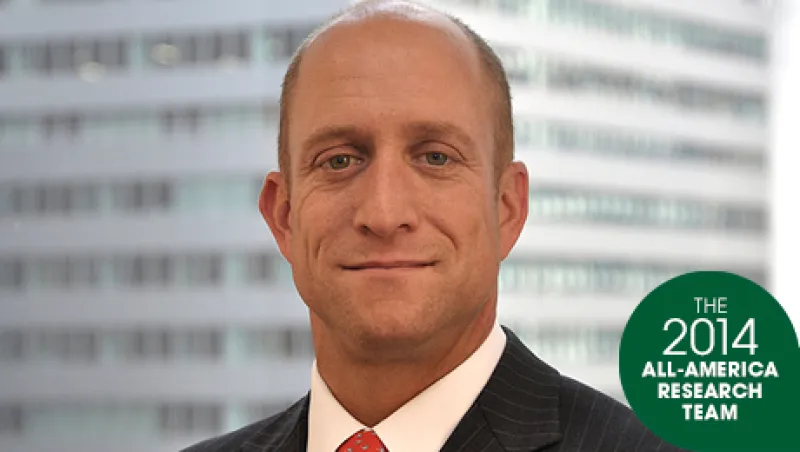J.P. Morgan reorganized its research operations in May, with Nicholas Rosato replacing Noelle Grainger as head of North American company coverage. (Grainger was promoted to global head of equity research.) But one thing that hasn’t changed is the firm’s dominance on the All-America Research Team, Institutional Investor’s annual ranking of the nation’s most highly regarded sell-side equity analysts. J.P. Morgan leads the team for a fifth year running and also celebrates its third consecutive monthly victory in an II survey. In August the analysts under the direction of Pedro Martins Jr. took top honors on the Latin America Research Team, and last month the crew guided by Peter Acciavatti, Eric Beinstein and Matthew Jozoff finished in first place on the All-America Fixed-Income Research Team.
Rosato, who earned a bachelor’s degree in finance at the University of Rhode Island, joined J.P. Morgan via its 2008 acquisition of Bear Stearns Cos., where he worked as research product manager.
The pending end of the Federal Reserve’s third round of quantitative easing, slated for later this month, has many investors anxious. II Director of Research Thomas W. Johnson asked Rosato, 45, to describe what he thinks investors can expect in the weeks and months ahead.
Sharp corrections accompanied the ends of QE1 and QE2. Will a correction accompany the end of QE3? Why or why not?
The tapering and end of QE3 have not been data-dependent but virtually automatic and thus are not by themselves causing the market moves — in contrast with the first two instances, which coincided with stronger activity data. We forecast a federal funds rate of 1 percent by year-end 2015, 2.5 percent by year-end 2016 and 3.5 percent by year-end 2017. After seven years of easy money and with the weakest recovery since World War II, Jan Loeys, head of global asset allocation at J.P. Morgan, expects that equities will likely be nervous and volatile, but with strong growth should still end up higher in 2015. He anticipates that the start of U.S. rate hikes is likely to weigh on markets over the short term, but that there should be greater differentiation over the medium term between liquid and less-liquid assets.
Housing starts tumbled in August and employers added only 142,000 jobs that month — signs that the U.S. economic recovery remains shaky. Is there any chance the Fed might extend QE3 or introduce some other measures to ensure the sustainability of the recovery?
Even with the latest housing results coming out weaker than expected, our economists think that the broader trend in the data still looks relatively upbeat and that real residential investment will increase at an 11 percent seasonally adjusted annual rate in the third quarter as part of our 3 percent real gross domestic product growth forecast for the period. Meanwhile, the Fed has indicated that it sees the modest disappointment in August payrolls as statistical noise around a generally favorable trend. Our economics team sees almost zero chance that the recent economic data will lead the Fed to extend QE3. [Editor’s note: Job growth rebounded in September to 248,000, the Labor Department reported in early October.]
U.S. stocks keep rising to record highs, but trading volume has remained light by historic standards. Why have many investors chosen to sit out this bull market?
Recently released Fed data indicate that the share of households directly owing equities has declined in recent years, consistent with a view that the equity rally has not seen broad participation. According to Bruce Kasman, J.P. Morgan’s chief economist, evidence from the generation that lived through the Great Depression indicates that it had a lasting effect on attitudes toward risk-taking. A similar phenomenon may have caused the generation that lived through the Great Recession to be more cautious in their personal finances. Looking at this from another perspective, Marko Kolanovic, J.P. Morgan’s global head of quantitative and derivatives strategy, notes a nearly 50 percent decline in equity share volumes since 2007, and that volume and volatility are highly correlated and linked by a positive feedback loop — lower volumes lead to lower volatility, and vice versa. Relatively high valuation of equities is also not supportive of higher volumes and volatility, as value-driven investors gradually step away from the market.
What is your outlook for the year ahead in terms of GDP growth?
We expect growth over the next four quarters will come in at about 3 percent. We forecast that the housing recovery will gain traction, which should aid industries tied to the residential investment cycle. Meanwhile, our economists believe that export growth could be challenged by the stronger dollar, which likely will hurt industries with domestic production bases and high exposure to foreign demand. Loeys continues to favor an underweight in U.S. small versus large caps, as the relative expensiveness of the former has not yet corrected. According to his analysis, combining short interest with momentum to trade U.S. equity sectors favors U.S. technology and utilities against telecommunications and financials.






